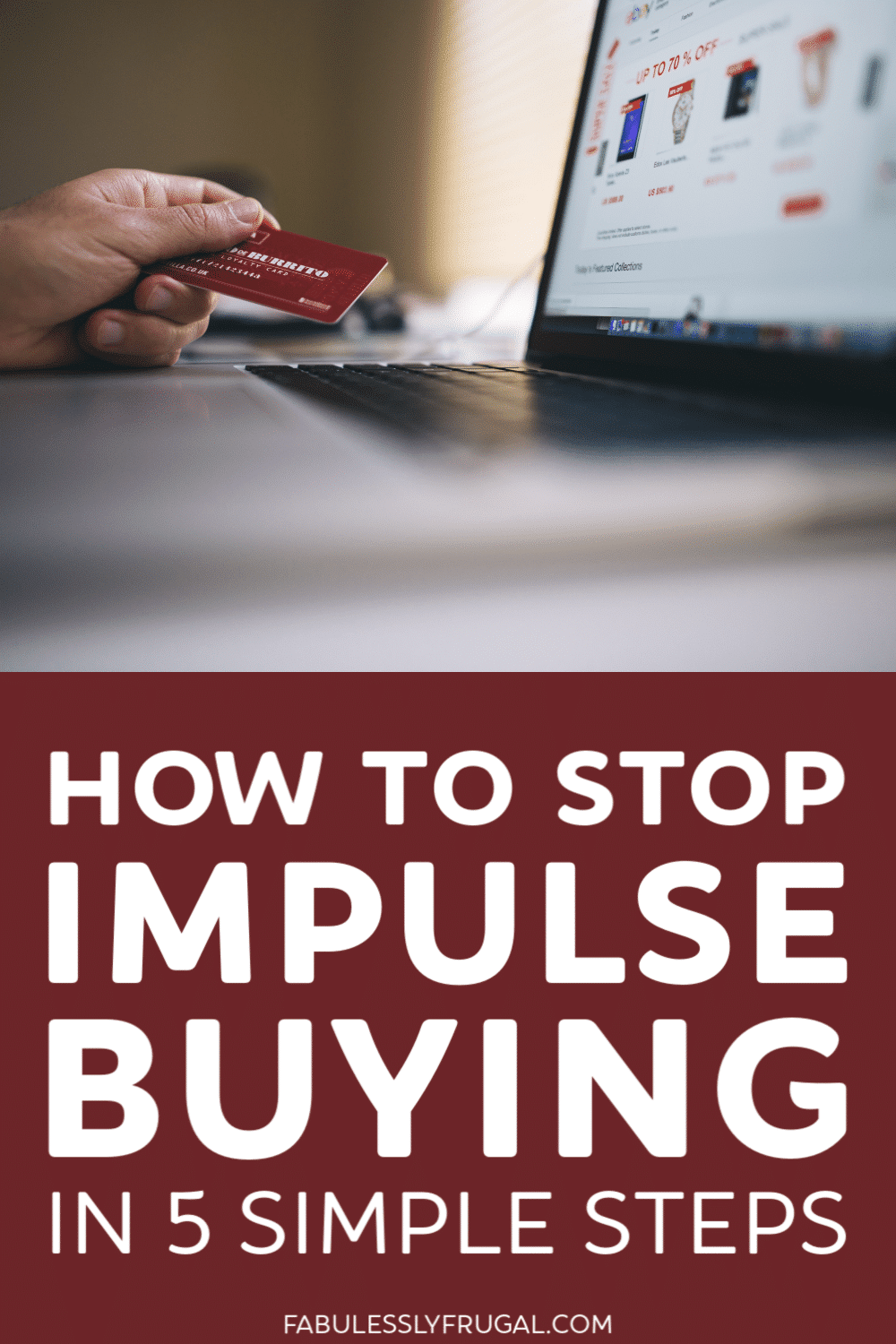How to Stop Impulse Buying for Good (In 5 Steps)

What is Impulse Buying?
Impulse buying, simply put, is when you make an unplanned purchase in the heat of the moment.
Some examples of impulse buying could be when you see something for sale online so you quickly buy it to take advantage of the deal, or when you’re in a checkout line and you see a magazine or pack of gum that you suddenly want to buy. These are purchases that you didn’t plan on making beforehand, but under the circumstances, you decided to make them anyway.
If you want to cut down or stop impulse buying completely, follow the 5 steps below.
How to Stop Impulse Spending in 5 Simple Steps
Impulse buying is a bad money habit that can seem impossible to manage. There are so many things to purchase these days and with online shopping, it’s easier and quicker than ever to spend money.
Just take a look at some impulse buying statistics in America and you’ll see that you’re not alone with this problem: CNBC found that the average consumer spends $5,400 per year on impulse purchases with most buys going toward food and clothing.
So what are the effects of impulse buying? Well, since a lot of impulse purchases are put onto credit cards, they can cause a lot of financial stress and feelings of guilt later on. But, if a ton of other people are having problems with impulsive shopping too, what can you do? Well, it’s important to first look at WHY we impulse buy…
Step 1. Find the Source of the Problem
The first step to controlling your impulsive spending is figuring out WHY it’s happening. Many people will find that they have triggers that set off bouts of impulse spending, and then, later on, they regret the purchases.
For example, there are many people who go impulse shopping online as a form of entertainment or distraction. They know they shouldn’t be buying anything, but they still do it because it makes them feel something. If that’s the case for you, it’s important to find something else to fill that void instead of shopping.
For others, it might be their friends that are causing them to make impulse purchases. When you’re around other people who are spending money and they’re encouraging you to do the same, it’s hard to be the odd one out.
To figure out what’s causing your impulse buying, take a look at your past credit card statements and purchase history and see where your money is going. Are you impulse buying a lot of food? Are you spending a lot of money online when you’re stressed out?
Knowing what’s causing your spending problems is going to help a ton right off the bat as you’ll be more aware of it. The next step is to work on eliminating the problem.
Step 2. Eliminate the Problem
Now that you know what’s causing your impulse purchases, it’s time to eliminate the problem so that it doesn’t keep on happening. While this seems like an easy step, it’s really the hardest step in this entire process. Just know that if you make a mistake, don’t be too hard on yourself, just get back on track as quickly as you can.
So how do you go about eliminating your spending “trigger”? Well, it will be different for each situation, but here are some examples:
If you go on a lot of online shopping sprees when you’re feeling stressed out, you obviously can’t just tell yourself to stop being stressed. That’s why it’s important to find something that will calm you down that isn’t shopping. For example, you could take up a hobby like learning an instrument or knitting. You might want to get rid of your credit card too if you still can’t resist the urge to buy things online.
On the other hand, if your impulse spending happens because your friends keep inviting you out to go shopping, you might have to start saying no to those invites or you might want to ask your friends if they’d like to do something else other than shopping.
And, last example: If your impulse spending always happens at the grocery store because you shop while you’re hungry, stop shopping while you’re hungry! And maybe try making a list before you go too.
To summarize, take what you learned from step one and figure out some ways you can avoid the situations that were previously causing your impulse purchases.
Step 3. Give Yourself a “Fun Money” Budget
While there are many ways to stop impulse buying, one thing that never works is trying to cut guilt-free spending completely. If you try to do that, it will most likely just lead to relapse down the line.
So, instead of trying to go from uncontrolled spending to no spending at all, give yourself a “fun money” budget to spend on whatever you want, guilt-free, every month. This should help to curb your urges to go impulse shopping and it will define some limits for your spending.
Step 4. Put the Rest of Your Money Somewhere Else
Once your bills are covered and you have a certain amount of money in your chequing account or in cash for guilt-free purchases, it’s time to move any money that’s leftover somewhere else. Preferably somewhere away from your main bank account.
The reason why is because you want it to be harder to access. Not impossible, just out of the way. This way you won’t see extra money in your account and mistake it for spending money.
Another big benefit of doing this is that it allows you to start building a nice nest egg. You could put this extra money into a high-interest online savings account as an emergency fund, or if you already have that covered, you could start investing it. The important part is to just do something with it rather than having it sit there.
Step 5. Come up with Purchase Questions
Purchase questions are questions you ask yourself before you buy something. These questions will help you determine right away whether something is worth buying or not. While everyone has different questions they ask themselves, here are some examples to get you started:
- Do I really need this?
- Will I use this? Or even better: Will I use it often enough for it to be worth the money?
- Does this fit in with my financial goals?
- Would I purchase this if it wasn’t on sale?
Keep your list of questions in your phone or somewhere easy to access and remember to look at them before making any unplanned purchases. The hardest part will be being honest with your answers.

Other Tips to Help Stop Impulsive Shopping
1. Postpone Your Purchases
We talked about this in our frugal habits post and it’s one of the best ways to stop impulse buying… but it only works if you actually commit to it. It’s a really simple concept too: Before making any SMALL impulse purchases (e.g. under $50) wait 24 hours. If it’s a limited-time sale and you can’t wait that long, you should only buy it if you have room in your “fun money” budget.
For bigger purchases (e.g. over $100), you should wait even longer. I like to wait at least a month before making any big purchases as most of the time my desire for whatever I wanted fades.
2. Stay Away from Stores Unless You Really Need Something
If you’re trying not to spend money, it doesn’t really make sense to hang around at the mall or your favorite store (even if you tell yourself you’re just going to browse). There’s a good chance you’ll see something you like and you’ll want to buy it.
3. Unsubscribe from Promotional Emails
When you first visit a stores website, you’re typically met with an offer of some sort. Something like, “Sign up for our newsletter and get 15% off your first order!”.
While this seems great at first, there’s a good reason why retailers do this: Once they have your email, they can send you tons of promotions. If they’re having a sale, they’re going to let you know about it.
And although this seems great as you’ll never miss a deal, it can cause you to make a lot of online impulse purchases buying things you don’t really need just because they’re on sale or “limited-time-only”. So, either unsubscribe from the promo emails or put them all on a separate email that you don’t use as often.
4. Start Cooking More
If you want to know how to stop impulse buying food, the quickest way is to start cooking from home more often. Think about it: What’s the number one reason why we impulse buy food? Because we’re hungry and we’re too tired to make anything.
But…what if you had a delicious freezer meal sitting at home that you could simply heat up quickly and enjoy? Would you still have the same urge to order take-out or hit up the drive-thru on the way home? Probably not.
Learn more about easy meal prep, quick meals, and freezer meals:
- Find all our make-ahead/freezer meal recipes.
- How to Spend Less Money on Food (But Still Eat Well)
- Prepear Review: Best Free Meal Planning App I’ve Ever Used!!
- 7 Meal Planning Tips That Will Save You Time and Money
- How to Eat Healthy on a Budget (15 Tips)
5. Think About the Time Cost
Thinking about a purchase in terms of time can really make you think hard about whether it’s worth it or not. For example, if you’re about to purchase something that costs $100 and you make $20/hour, that’s 5 hours of work right there. Is that purchase worth 5 hours of work?

Final Thoughts
Impulse buying can have a detrimental effect on your finances but it’s also one of the hardest habits to get out of. It’s not as simple as just saying “I’m going to stop impulse spending now.” It takes hard work and willpower to overcome.
For that reason, as I said above, don’t feel bad if you make an impulse purchase every now and then. Instead, figure out what caused it, learn from it, and continue working toward the solution. You can do this!
Other Helpful Posts:
- 9 Unexpected Expenses You May Forget to Budget For
- How to Make a Budget With 7 Bank Accounts
- How to Make a Simple Budget Easily in 5 Steps!
- How to Save Money on Clothes (15 Clever Tips)

Comments
Leave a Reply
Report a Problem
Please select the problem you are facing with this deal:
- Price Increased
- Price Decreased
- No longer available
- Expired
- Link doesn't work
- Suggestion
- Compliment
- Other
Add more details:
Thank you for your feedback. We really appreciate it.
Enter your email address if you would like
to receive a follow up.
Please Try Again
Thanks for providing the email address.
We will reach out to you as soon as possible.





















I loved the article, I identified a lot and I will send my husband to read.